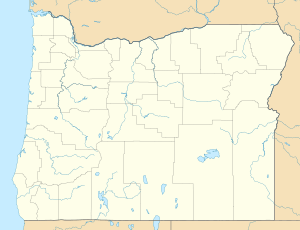Myrtle Creek (South Umpqua River tributary) facts for kids
Quick facts for kids Myrtle Creek |
|
|---|---|
|
Location of the mouth of Myrtle Creek in Oregon
|
|
| Country | United States |
| State | Oregon |
| County | Douglas |
| Physical characteristics | |
| Main source | confluence of North Myrtle Creek and South Myrtle Creek Myrtle Creek 594 ft (181 m) 43°01′24″N 123°17′01″W / 43.02333°N 123.28361°W |
| River mouth | South Umpqua River Myrtle Creek 581 ft (177 m) 43°01′22″N 123°17′45″W / 43.02278°N 123.29583°W |
| Length | 1 mi (1.6 km) |
Myrtle Creek is a small stream in Oregon, a state in the United States. It flows into the South Umpqua River in Douglas County. The main part of Myrtle Creek is only about 1 mile (1.6 km) long.
This main stream forms where two other streams meet. These are called North Myrtle Creek and South Myrtle Creek. Both of these "forks" are much longer than the main stream itself.
The area around Myrtle Creek is managed by the Bureau of Land Management. It has a large, unbroken forest with many streams. This forest is home to animals like coho salmon and the northern spotted owl. It also helps provide clean drinking water for people. You can enjoy many outdoor activities here. These include hiking, gathering mushrooms, camping, and horseback riding.
In 1990, the city of Myrtle Creek built a special bridge. They used large wooden beams from an old bridge in Lane County. This new covered bridge goes over Myrtle Creek. It connects a parking area to the city's Mill Site Park.
North Myrtle Creek
North Myrtle Creek starts high up in the Cascade Range mountains. It begins on the slopes of Buck Peak. From there, it flows mostly towards the southwest.
Many smaller streams flow into North Myrtle Creek. These are called Buck Fork, Lee Creek, Slide Creek, Frozen Creek, Big Lick Creek, Little Lick Creek, and Bilger Creek.
The China Ditch Project
People found gold in Douglas County a long time ago, starting in the 1860s. In 1891, a big project called the China Ditch began. This was a human-made waterway, about 33 miles (53 km) long. Hundreds of Chinese workers helped dig it.
The ditch was built to bring water from the Little River to North Myrtle Creek. This extra water was needed for large machines. These machines used water pressure to dig for gold, a process called hydraulic dredging. The goal was to dig for gold all year round. However, by 1894, the project did not find enough gold to cover its costs. So, it closed down.
Today, the Bureau of Land Management looks after a part of the ditch. About 11 miles (18 km) of it have been saved. You can visit the area by car using a special loop of roads. There is also a 4,000-foot (1,200 m) trail. Along the way, signs explain the history of the China Ditch.
South Myrtle Creek
South Myrtle Creek also starts in the Cascade Range. It begins near Deadman Mountain in the Umpqua National Forest. It flows generally towards the west-southwest.
Several smaller streams join South Myrtle Creek. These include Curtin Creek, Johnson Creek, Lally Creek, Weaver Creek, Letitia Creek, Long Wiley Creek, Short Wiley Creek, and Louis Creek. Also joining are Ben Branch, School Hollow, and Cedar Hollow.
There is another covered bridge over South Myrtle Creek. It is called Neal Lane Bridge. This bridge carries Neal Lane over the creek near the city of Myrtle Creek. The bridge is 42 feet (13 m) long. It is special because it is the only covered bridge in Oregon with a kingpost truss design.


